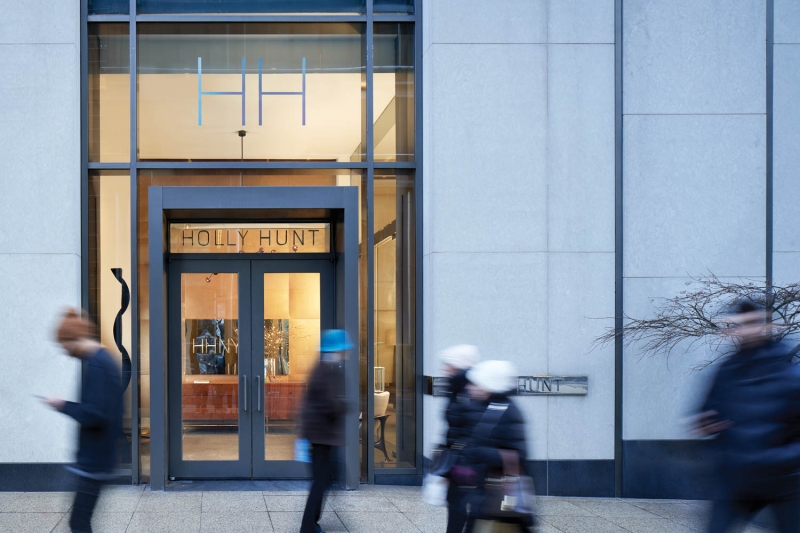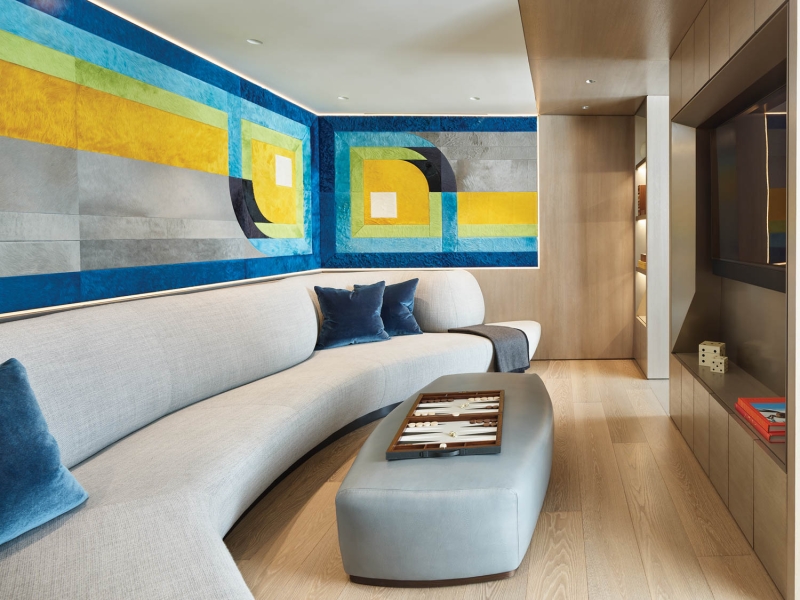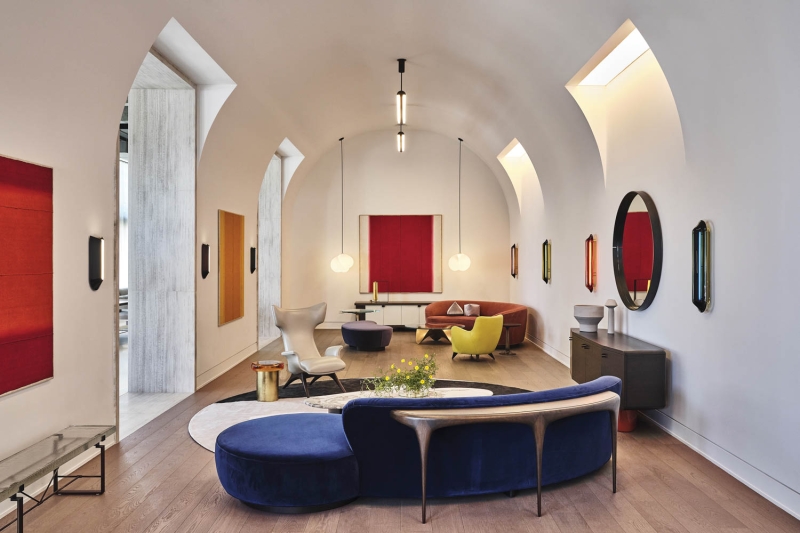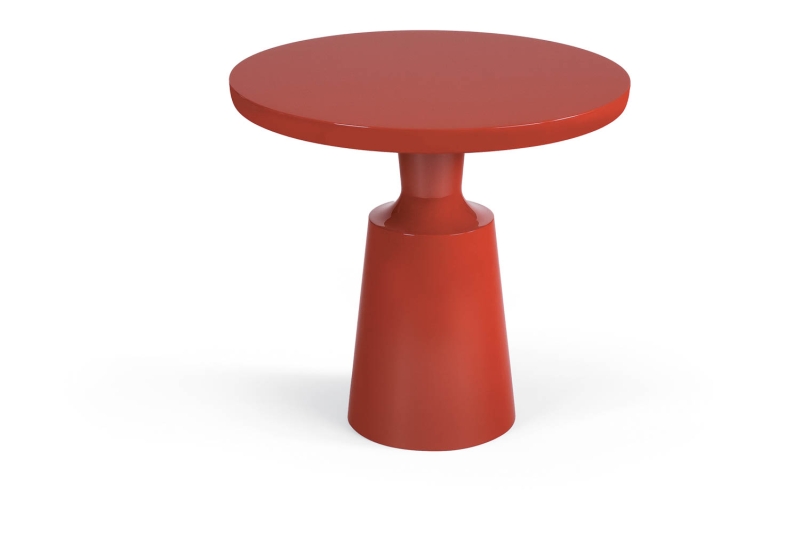Contents
The HOLLY HUNT Miami showroom, 2015. Photography by Jonathan Allen.
Even if you never met Holly Hunt, you could pick her out in a crowd. She is a doyenne of an exquisitely understated, timeless modern style, who worships fine materials and artisanship and is heavily into neutrals. That woman with the perfectly coiffed silver hair and contrasting slim, dark jacket, surrounded by museum-quality artwork and impeccably tailored furnishings? Yep, that’s her.
An entrepreneur, Hunt revolutionized the design, production, marketing, and sale of custom furniture through the eponymous company she founded in 1983. But she was not to the showroom born. As she writes in her recent memoir, Holly Hunt: Fearless in the World of Design, she was born in 1942 in San Angelo, Texas, to a family loaded with professional degrees; a great-uncle was the doctor who delivered Elvis Presley, and both her parents were educators. Her high school years were spent in Anson, a tiny town near Abilene (which later became notorious as the inspiration for the 1984 movie Footloose).
Encouraged to take up teaching herself, Hunt majored in English at Texas Tech. But what she really wanted was to work in fashion. After graduating, she entered the executive training program at Foley’s, a Houston department store, and later landed a job there as an assistant buyer in millinery. In 1969, she lit out for New York City and began designing for a costume jewelry company.
Hunt’s book begins with her marriage to Ron Tackbary, whom she met in 1973 and settled with in Chicago. In 1983, she took over R.J. Randolph, a faltering showroom at the Merchandise Mart that gave her the ability to buy furniture at a discount. She and Tackbary divorced soon after; Hunt was left to run the business and raise their three young sons. Aside from changing the company name to her own and deciding to represent designer collections, her only business plan was the conviction that she could do better. “Most showrooms had terrible customer service and awful product display practices,” she recounts. “Lines were thrown on the sales floor helter-skelter, so that it was difficult to see what went with what.” Customers endured lengthy delays and fabrication mistakes. There was no transparency in pricing. Decorators bought the furniture at a discount and could charge whatever they wanted to clients, pocketing the difference, and eroding trust when discrepancies were exposed.

The founder of HOLLY HUNT at her House of Hunt studio in Chicago, 2024. Photography by Maria Ponce.
How Holly Hunt Changed The Industry Game
Hunt did away with all that. Expanding first to Minneapolis in 1985, then New York’s D&D Building in 1994 and Washington in 1999, ultimately reaching a total of 12 showrooms nationwide, she revealed designer net prices (much to the industry’s disgruntlement) and insisted on taking responsibility for orders even when it cut into her profits. She also took the radical step of creating showrooms that looked like places where clients might actually want to live, with architectural detailing, artwork, and a mix of products and styles.
In these rooms she displayed pieces by such established designers as Vladimir Kagan and Rose Tarlow, helping to turn talents into luminaries, and lesser-knowns that she discovered, including Los Angeles glass artist and lighting designer Alison Berger and French sculptor and furniture maker Christian Astuguevieille. She hired the avant-garde graphics studio Thirst to mold a sophisticated modern image in print advertising and marketing materials. The common thread binding everything together was superior quality.

Holly Hunt and Christian Liagre. Photography by Marlene Rounds.
In the early ’90’s, Hunt met Christian Liaigre in Paris. She could see by the French furniture designer’s sleek, monochromatic clothing, which was much like her own, that they were creative soulmates. “Fashion sets the tone for everything in design,” she says. Soon she was manufacturing and selling Liaigre in the U.S., transforming the look of American interiors so that they glowed with sleek, dark woods and creamy textiles. “It was art collectors who were buying it, who understood the clarity and cleanliness and classic proportions,” she recalls. The ultimate seal of approval came in 1997, when André Balazs’s Mercer Hotel opened in downtown Manhattan with Liaigre-designed interiors.
Inside Holly Hunt’s Notable Showrooms
Hunt’s excellent judgment led her to launch a showroom in the Miami Design District in 1998, the very early days of a neighborhood that’s now chockablock with the likes of B&B Italia and Burberry. Her idea was to create something different from a nook in a maze—a template set by the Mart. Conceived by architect Alison Spear, it had the vibe of a luxury boutique and was accessible to all. “It was the first showroom in the country where people came to see it for the showroom,” Hunt says.
She repeated the experiment with her second Manhattan showroom, which was renovated to look like “a street-level jewel,” she notes. It had been scheduled to open in the Architects & Designers Building in October 2001, but then 9/11 happened. Hunt saw beyond the chaos and delayed the opening a mere two months. The showroom was there, waiting, when normality was restored to the traumatized city.

Inside the A&D showroom with Stefan Gulassa’s Helios chandelier, 2016. Photography by Marlene Rounds.
Hunt was equally agile when the 2008 recession hit, streamlining and restructuring the company, which had 250 employees by that time. Two years later, just as it was returning to economic health, Liaigre sold his business to private investors. “We’re going to design our way out of this,” she told her staff, launching Holly Hunt Modern, a collection that was even more profitable than her partnership with the Frenchman had been.
Some of Hunt’s successes were so big they exerted gravitational pulls. In her book, she describes offers she couldn’t refuse that led her to part with things she dearly loved, namely her company. In 2014, Knoll bought it for $110 million. She retained her CEO position for two years and oversaw the planned expansion of showrooms in Dallas and L.A. She remained a consultant until 2019, while designing such projects as a penthouse at the Surf Club in Miami Beach.

The Surf Club penthouse’s pool deck. Photography by Nathan Kirkman.
Today, she presides over House of Hunt, a boutique interior architecture and furniture studio in Chicago that weaves together many creative strands at every scale, from the design of such products as the Dune sofa for HOLLY HUNT to the renovation and development of whole homes, with residences in Colorado and Florida among the firm’s current and recently completed projects. Hunt still doesn’t have a business plan and that’s just the way she likes it—being challenged as she goes.
Explore More of Holly Hunt’s Interior Designs

Holly Hunt’s Aspen, Colorado, residence, a House of Hunt project, 2023. Photography by Bjorn Wallander.

The HOLLY HUNT Miami showroom, 2015. Photography by Jonathan Allen.

The Architects & Designers Building showroom in New York, 2008. Photography by Marlene Rounds.

The stairway in the Aspen residence. Photography by Bjorn Wallander.

The Holly Hunt–designed penthouse at the Surf Club in Miami Beach, 2019. Photography by Nathan Kirkman.

The media room in the Surf Club penthouse. Photography by Nathan Kirkman.

The Dallas showroom, 2015. Photography by Jonathan Allen.

The Los Angeles showroom, 2022. Photography by The Ingalls.
Discover Holly Hunt’s Collaborations

Hunt with Vladmir Kogan in his prototype chairs, 2015. Photography by The Ingalls.

A Kagan sofa sketch.

The Mandarin lounge chair, 1998, by Christian Liaigre.

The Courrier dining table, 2000’s, by Christian Liagre.
A Look At Trailblazing Product + Branding Projects

Hunt in The Financial Times, 1987.

The cover of Hunt’s recent memoir, Holly Hunt: Fearless in the World of Design, featuring marketing imagery from the 2010’s. Photography by Kendall McCaugherty.

A 1985 ad by Chicago graphic designer Rick Valicenti.

A marketing campaign photographed in the Hamptons by Paul Warchol.

The Siren dining chair. Photography by Jonathan Allen.

Bridger daybed. Photography by Jonathan Allen.

Ronin side table. Photography by Jonathan Allen.

Peso side table. Photography by Jonathan Allen.

Alison Berger’s Body and Heart pendant fixture, 2019. Photography by Jonathan Allen.

Christian Astuguevieille’s Rhizo table. Photography by Jonathan Allen.

House of Hunt’s Dune sofa, 2023. Photography by Nathan Kirkman.

